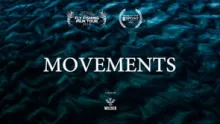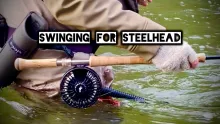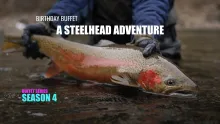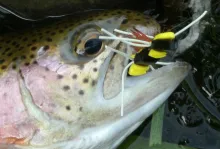In Denmark fishing for escaped sea farm rainbows is possible when a cage breaks. The sport is good and you can catch - and kill - several prize size fish in the 50-60 cenimetre or 20-24" range in a day, helping removing them from nature.
We do not have extensive sea farms in Denmark, but we do have a few. Compared to Norway and its huge salmon industry, our meagre cages with rainbows are like Old McDonald's cozy farms compared to modern, large scale, industrial farms.But still we do have them, and still a cage occasionally does break open and thousands of fish escape. And when that happens it is time to grab the rod and hit the coast!
Unwelcome
The rainbows may be a fun encounter for the fisherman, but regarded as an addition to the fauna of the Baltic Sea, these originally North American fish, are not welcome.
The rainbow is generally not considered to be able to spawn successfully in the Danish streams, but these feisty fish are able to survive well in both salt and fresh water.
And in doing so they occupy precious space from our wild fish, mainly the brown and sea trout and the salmon and mainly in the streams that are few and small in many parts of the country. There is no doubt in my mind that the many large rainbows will compete for space and food and probably also consume eggs from the wild fish during their spawning.
Whether the rainbows spawn or not is not well documented, but if they do, it is with the added risk that they will dig up eggs laid by wild fish earlier in the spawning season..
Not natural
The rainbows are unnatural in many respects. Being a non-indigenous species it has no real place in the eco system other than the one already taken by mainly sea trout, which are mostly wild fish.
Also these fish are behavioural retards, so to speak. They are hatched in tanks, smoltified in the same place and have grown large in big, floating cages where thousands of fish swim in great schools in a very confined space in mid water. There is no bottom (except for the net), no natural obstacles and first and foremost no naatural food items.
The fish are fed with pellets which are sprayed over the surface every day, and these fish are so tuned in on feeding on these sinking lumps, that they seem to have no affinity towards moving prey - or flies - during their first period in the free. A wise fly tier once devised the pellet fly, and that would probably work well on these fish.
Escapees
When these fish escape it can have many reasons. The cages sometimes just leak and a few fish can sneak out. No big deal. I imagine that many of these singles will just stick to the cages and live a monotonous life just on the other side of the net wall.
But sometimes whole cages break open allowing tonnes of fish numbering thousands to escape. In such cases the fish seem to roam in large schools, and they will eventually get to the shore, which is never far away in the enclosed seas of Denmark. This often happens during the autumn when the sea is rough and the wind can reach high speeds.
The fish are usually big - about 2-3 kilos (4-6 lbs) and well into the 50-60 centimetre or 20-25 inch range. That can be compared to the average 2-3 lbs sea trout that are common on the Danish coast. The rainbows are also fat due to the rich food source in the sea farms..
Tailless
Was it not for their scars and lack of tails, they would actually be beautiful fish. But just after the escape they are usually still marred by a totally bitten down tail - often none at all - and scars from fights and encounters with each others, the net walls and the cage.
Their looks will improve greatly during an autumn and a winter, and when caught in the spring or summer they are amongst the most beautiful fish in our waters, often rightfully referred to as steelhead..
How to catch an escapee
The escaped fish are confused at first. they do not seem too bright and do not appear to really eat. The usual hunting behaviour we see in sea trout is not there, and the fish will swim about in large schools not doing anything obvious.
They will reveal themselves in the shallow water, and can often be targeted with precise casts. But opposite the sea trout, they will not turn and attack a fly immediately.
Many times they will shun away, and seem more frightened than attracted. Other fish will show interest but follow the fly and not take it. Others again will nibble on the fly, and be reluctant to swallow it while a last small fraction will act much like sea trouts: god for the fly upon seeing it, strike and immediately turn.
The longer the fish stay in the free the more their behaviour will come to be like a wild fish'
Small flies seem to work well, and we have had particularly good luck with orange ones. Basically some orange dubbing on a size 8 hook will do the trick.A bit of weight will not hurt and you can vary the color in the orange, cream and brown spectre. The fly is very efficient for sea trout too, should one pass by.').
The beast must die!
Beautiful or not, these fish are killed upon landing. As already mentioned they are not natural in the Danish seas and are not welcome as anything else than a fishers' game.
Even considered as such I personally still find myself in a dilemma between the advantage of being able to catch several prize size fish in the 50-60 cenimetre or 20-24" range in a day, and saving nature the burden of these fish, which no one really knows what will do to the natural sea trout.
So preventing future escapes is important, but when new outbursts of rainbows happen, I will gladly be there to catch them again.
- Log in to post comments








This is a problem al
This is a problem all over. I've read that due to escapee fish, there's now an Alantic Salmon population that runs in rivers on the west coast of North and South America.
North Pacific Chinook salmon have started to establish themselves on both coasts of South America due to escapees as well.